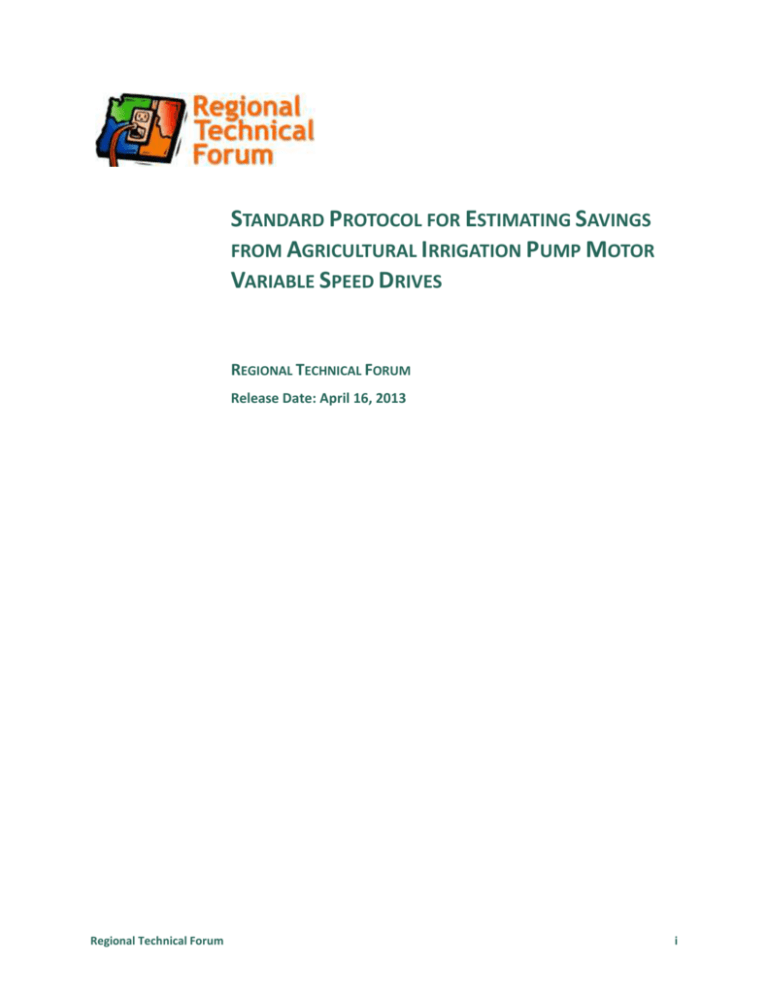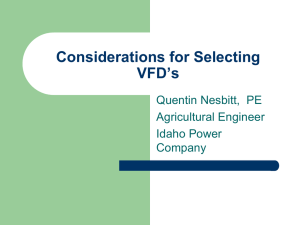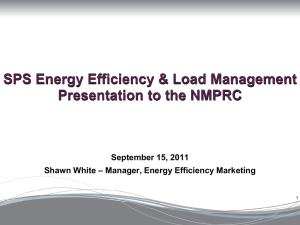Standard Protocol - Agricultural Irrigation Pump Motor VFD
advertisement

STANDARD PROTOCOL FOR ESTIMATING SAVINGS
FROM AGRICULTURAL IRRIGATION PUMP MOTOR
VARIABLE SPEED DRIVES
REGIONAL TECHNICAL FORUM
Release Date: April 16, 2013
Regional Technical Forum
i
Standard Protocol - Agricultural Irrigation Pump Motor VFD
TABLE OF CONTENTS
1. PURPOSE............................................................................................................ 1
2. SUNSET DATE ...................................................................................................... 1
3. DEFINITION
OF KEY TERMS ..................................................................................... 1
4. ELIGIBLE PROJECTS ............................................................................................... 1
5. REQUIRED KNOWLEDGE AND SKILLS OF PRACTITIONER ................................................... 2
6. DELIVERY VERIFICATION ......................................................................................... 3
7. DATA COLLECTION REQUIREMENTS ........................................................................... 3
7.1. Pump and Pump Motor Specifications .............................................................................. 3
7.2. Specifications for Additional Equipment on the Metered Circuit ..................................... 3
7.3. Specifications for Additional Program Measures Affecting the Metered Circuit .............. 4
7.4. Baseline Electricity Consumption ...................................................................................... 4
7.5. Inputs for Cost-Effectiveness Analysis ............................................................................... 4
8. PROVISIONAL DATA REQUIREMENTS ......................................................................... 5
9. SAVINGS ESTIMATION STEPS ................................................................................... 5
9.1. Determine Average Annual Baseline Consumption for the Pump .................................... 6
9.2. Compute Savings Using the Simplest Reliable Method ..................................................... 6
9.3. Compute Savings Using the Best Practice Method ........................................................... 6
9.4. Life Cycle Costs and Benefits ............................................................................................. 7
10. SAMPLING PROCEDURE ........................................................................................ 7
11. RELATIONSHIP TO OTHER PROTOCOLS AND GUIDELINES ............................................... 7
12. TYPICAL COST OF APPLYING THIS PROTOCOL ............................................................. 8
13. USER’S GUIDE TO THE SAVINGS CALCULATOR ............................................................ 8
ii
Regional Technical Forum
Standard Protocol - Agricultural Irrigation Pump Motor VFD
1. PURPOSE
This provisional protocol establishes a method by which annual electrical energy savings (kWh) can be
estimated for a turbine style pump in agricultural irrigation applications that has been upgraded by the
addition of a Variable Frequency Drive (VFD). VFDs reduce electric use by adjusting the pump motor’s
speed to better match the required pumping output. With improved sprinkler systems, some pumping
plants are currently oversized, and do not require nameplate head or flow. Head requirements may also
vary throughout the growing season for ground water systems. VFDs reduce electric use by adjusting the
pump motor’s speed to match the required load and alleviate the need for less efficient methods of
regulating flow rates, such as throttling values or return flows (i.e. “pump and dump”).
This protocol specifies minimum acceptable data collection requirements and the method by which
these data are to be used in computing savings. For some data elements, alternative sources of data,
considered to be of superior quality, are also defined and are allowed. Savings are computed using the
methods within the Excel workbook that accompanies this document to ensure standardized application
of the savings estimation methods.
This protocol also specifies a best practice method of estimating savings. Both the best practice and
provisional methods should be used. When sufficient data has been collected from the use of both
methods, the RTF may consider changing the category of this standard protocol from provisional to
proven.
2. SUNSET DATE
This provisional protocol is approved for use until April 30, 2016.
3. DEFINITION OF KEY TERMS
Project. A VFD installed to control one turbine pump. The baseline control mechanism (e.g., throttling
valve, pressure reducing valve, bypass valve) is either disabled and set to the appropriate condition or
removed.
Baseline. This modifier refers to the period prior to the upgrade.
Post. This modifier refers to the period after the pump unit VFD upgrade is installed and fully
commissioned.
Operational. A VFD is determined to be operational if it is energized, set to the automatic motor speed
adjustment setting, and is capable of providing power to the motor at a frequency of less than 60 Hz.
4. ELIGIBLE PROJECTS
Following criteria define the eligible pump upgrade projects:
Regional Technical Forum
1
Standard Protocol - Agricultural Irrigation Pump Motor VFD
Pumps must be vertical, submersible or line shaft turbine pumps used for agricultural irrigation
purposes. Centrifugal and positive displacement pumps are not eligible under this protocol.
Pump motors must have a horsepower (HP) rating between 20 and 500 HP.
Pump motors must be single speed motors.
Pump motors must not be subject to a local energy code requirement for variable speed drive.
The baseline control strategy must rely on throttling valves, with or without recirculation.
Pump must have a variation in flow requirements of 20% or more, or a reduction in pressure
requirements of 10% or more.
All throttling valves and recirculation devices must be removed or rendered non-operational as part
of the measure installation.
The baseline pump load must be disaggregated from the available metered data. The upgraded pump
can share a circuit with the following equipment:
Electric motors of much smaller capacity than the upgrade equipment, such as center
pivot drive motors.
Additional pumps that are being upgraded simultaneously.
Additional pumps and other equipment that the operator of can estimate the annual
hours of operation for.
Three years of metered annual kWh consumption must be available.
If the computed estimate of baseline annual hours of operation is greater than 2,500 hours, then
the practitioner must verify that the computed hours of operation is consistent with the operator’s
estimate of hours of operation. The estimate of hours of operation should be computed from the
following equation: Hours of Operation = [Baseline Average Annual kWh] / { [Pump Motor HP] x
[0.746 kW/HP] x [Motor Loading Factor]} , where the Motor Load Factor is equal to 1.0.
5. REQUIRED KNOWLEDGE AND SKILLS OF PRACTITIONER
The practitioner who has lead responsibility for applying this protocol to a pump unit must have at a full
understanding of the following:
Appropriate safety procedures for collecting pump system specifications, including pump nameplate
data and baseline control specifications.
This protocol and the accompanying savings calculator.
The practitioner must also be able to successfully perform the following tasks:
Interview the pump operator to understand the need for VFD and the variation in flow or pressure
requirements
2
Regional Technical Forum
Standard Protocol - Agricultural Irrigation Pump Motor VFD
Identify, by inspection, the pump type and control strategy.
Collect necessary pump system specifications and billing or other metered energy consumption data.
6. DELIVERY VERIFICATION
This protocol may only be used for pump units that pass the following delivery verification tests:
The baseline control mechanism is either removed or disabled and set to the maximum flow
condition.
The practitioner must verify the VFD has been installed and is operational. The practitioner can
determine if the VFD is operational through inspection of the VFD display during operation. If the
system is in auto-mode and the driving frequency is 60 Hz, then the practitioner should have the
operator temporarily reduce the pumping requirements of the system; the practitioner can then
observe the system being driven at a frequency less than 60 Hz.
7. DATA COLLECTION REQUIREMENTS
The following data must be collected and entered into the savings calculator. The minimum acceptable
procedure for obtaining the data is specified. In some cases, alternative procedures are allowed which
would provide data of higher quality.
7.1. Pump and Pump Motor Specifications
Pump type. Determined by inspection.
The pumps must be vertical, submersible or line shaft turbine
pumps.
Baseline Control Strategy. Baseline system motor controls must be on/off, with or without pump
pressure or flow control devices that do not adjust motor speed.
7.2. Specifications for Additional Equipment on the Metered
Circuit
An inventory of equipment on the circuit must be compiled, that includes:
The type of equipment
The rated load of the equipment
For all equipment with a rated load greater than or equal to two percent of the rated load of the pump,
the following data must be collected.
Estimated annual hours of operation. Collected from the system operator.
Regional Technical Forum
3
Standard Protocol - Agricultural Irrigation Pump Motor VFD
7.3. Specifications for Additional Program Measures Affecting
the Metered Circuit
For any energy efficiency measures that were implemented on the metered circuit during the three year
pre-installation period, or during the same year as the VFD installation, the following information must
be provided:
Name of the measure
Date of the measure installation
Estimated measure savings. If there is an RTF approved estimate of savings for this measure, then
the RTF approved value should be used. Otherwise, the value estimated by the measure practitioner
should be used.
7.4. Baseline Electricity Consumption
Three years of baseline annual electricity consumption must be collected. Acceptable data sources are:
Utility metered data of a circuit that a pump is the only power-consuming equipment on.
Utility metered data of a circuit that the other equipment loads have been subtracted from.
Sub-metered data from a true RMS power meter.
7.5. Inputs for Cost-Effectiveness Analysis
The following data need to be gathered to support the cost/benefit analysis feature of the calculator.
Entries will be limited by the calculator to a restricted set of options. Certain entries are completely predetermined.
Project completion date.
Measure cost. The initial cost of installing the measure, including all materials and labor costs.
This is
the full cost of the VFD installation. This value must be supported by invoices or other
documentation.
The following values are used in the cost-effectiveness calculation, but are pre-set in the calculator.
Electric shape. The calculator assigns an appropriate electric shape for Northwest regional irrigation
pumping loads.
Periodic costs or savings. Any non-annual periodic costs associated with the measure, and the
associated time period. These are incremental costs of the efficient option over the costs of the
baseline. For a fan VFD, the calculator restricts this value to be zero.
4
Regional Technical Forum
Standard Protocol - Agricultural Irrigation Pump Motor VFD
O&M costs or savings. Annual O&M costs or savings associated with the measure. These are costs or
savings which occur with the efficient option that would not occur with the baseline option, i.e. the
costs associated with VFD maintenance. The calculator restricts this value to be zero.
Non-energy benefits. Annual non-energy related costs or savings associated with the measure.
The
calculator restricts this value to be zero.
Measure life. Number of years the measure is expected to be in effect.
For a pump VFD, the
calculator restricts this value to be 10 years.
8. PROVISIONAL DATA REQUIREMENTS
During the period that the RTF classifies this protocol as Provisional, the following data requirements
will be in force:
Post-installation Annual Electricity Consumption. One year of post-installation annual electricity
consumption must be collected. Acceptable data sources are:
Utility metered data of a circuit that a pump is the only power-consuming equipment on.
Utility metered data of a circuit that the other equipment loads have been subtracted
from.
Sub-metered data from a true RMS power meter.
Acres Irrigated. The number of acres irrigated by the irrigation system that the VFD is a part of
during
each of the three pre-installation years and during the year immediately following the installation.
Crop Type. The type of crop grown on the field(s) irrigated by the irrigation system during each of the
three pre-installation years and during the year immediately following the installation.
The following data should be collected if available:
Measured Flow Rate. The measured flow rate produced by the pump.
Irrigation System Type. {Gravity system / Sprinkler system / Drip, trickle, or low-flow micro sprinklers
/ Sub-irrigation }
9. SAVINGS ESTIMATION STEPS
Savings are estimated using the savings calculator that accompanies this protocol. Savings are
estimated as follows.
Regional Technical Forum
5
Standard Protocol - Agricultural Irrigation Pump Motor VFD
9.1. Determine Average Annual Baseline Consumption for the
Pump
Annual Baseline Pump kWh. For each of the three years, the following electricity consumption
amounts should be subtracted from the measured electricity consumption:
Estimated Consumption Of Additional Equipment. The estimated annual energy
consumption of each additional piece of equipment on the circuit, excluding equipment
with rated loads less than 2% of the pump rated load. Annual energy consumption for
other equipment is determined by multiplying the rated load by the operator’s estimate
of annual hours of operation.
Estimated Savings From Other Measures. For any additional incented energy efficiency
measures as described in section 7.3, the estimated other measure savings should be
subtracted from the metered data for all years prior to the installation. For example, if a
VFD were installed in the fall of 2013, and irrigation hardware measures had been
implemented in the fall of 2012, then the estimated savings from the irrigation hardware
measure would be subtracted from the 2011 and 2012 metered electricity consumption. If
the VFD and irrigation hardware were both installed in fall 2013, then the estimated
savings from the irrigation hardware measure would be subtracted from the 2011, 2012,
and 2013 metered electricity consumption.
Average Annual Baseline kWh.
Compute the average annual baseline kWh. This is the sum of
Annual Baseline Pump kWh divided by three.
9.2. Compute Savings Using the Simplest Reliable Method
Estimated Annual kWh Savings. Multiply the Average Annual Baseline kWh by Average Measure
Savings Percentage. The Average Measure Savings Percentage is 25%.
9.3. Compute Savings Using the Best Practice Method
The status of this standard protocol is provisional. Therefore, in addition to the savings estimation
method described in sections 9.2 and Error! Reference source not found., the best practice method
must also be used to compute savings.
Annual Post-installation Pump kWh.
This is the measured electricity consumption for the one year
immediately following the VFD installation, minus:
Estimated consumption of additional equipment. As described in section 9.1.
Estimated Annual kWh Savings. This is the Average Annual Baseline kWh minus the Annual Post-
installation Pump kWh.
6
Regional Technical Forum
Standard Protocol - Agricultural Irrigation Pump Motor VFD
Note that while the Acres Irrigated and Crop Type are provisional data collection requirements, they
are not used in the best practice savings estimation method. When sufficient data has been collected
under this provisional standard protocol, the RTF may use this information to inform either the Average
Measure Savings Percentage value or the savings estimation method for a standard protocol with
“proven” status.
9.4. Life Cycle Costs and Benefits
The calculator contains results of the ProCost model, which computes life cycle costs and benefits.
Inputs to the model include the estimates of first year savings described in sections 9.2, Error!
Reference source not found., Error! Reference source not found., and Error! Reference source not
found. and the cost-effectiveness input data described in section 7.5. ProCost computes life cycle costs
and benefits from the economic perspectives of the end user, utility, and region. The ProCost model for
this measure is available on the RTF website.
10. SAMPLING PROCEDURE
No sampling is permitted by this protocol. Data collection and savings estimation is required for each
upgraded pump unit regardless of the number of such units that may be upgraded at a facility.
11. RELATIONSHIP TO OTHER PROTOCOLS AND GUIDELINES
The relationship between this protocol and other relevant protocols and guidelines is as follows:
International Performance Measurement and Verification Protocol – 2007 (IPMVP), Efficiency
Valuation Organization. This protocol is consistent with Option A - Retrofit Isolation: Key Parameter
Measurement described in the IPMVP, as the key parameter is measured (baseline pump annual
energy consumption) and the additional parameter required for computing savings, percentage
savings, is estimated based on historical data.
M&V Guidelines: Measurement and Verification for Federal Energy Projects Version 3.0, U.S.
Department of Energy Federal Energy Management Program. The relevant part of this guideline
is Section 11.4 Variable Speed Motors. This guideline requires both baseline and post
measurements, which is not consistent with this protocol.
Verification by Equipment or End-Use Metering Protocol, 2011, Bonneville Power Administration. This
BPA guideline, based on ASHRAE Guideline 14-2002, in general requires both baseline and post
metering. The protocol described herein is based on baseline-only metering, although its provisional
form calls for pre- and post- metering.
Sampling Reference Guide, BPA. It is unlikely that more than 20 pump units would be upgraded as
part of any one project. It is difficult to obtain reliable sample estimates from populations this small,
Regional Technical Forum
7
Standard Protocol - Agricultural Irrigation Pump Motor VFD
especially given the likely variation in savings between units. Therefore no sampling is allowed. This
is consistent with the BPA guide.
12. TYPICAL COST OF APPLYING THIS PROTOCOL
Shown below is an estimate of typical cost of applying this protocol for a single pump unit. Projects that
involve more than one pump unit at the same facility are likely to see lower cost per unit. Expenses for
alternative measurements, allowed by this protocol, are not included in this estimate of typical cost.
Item
Quantity $ / Hour Rental Total Cost
Labor
Utility or Trade Ally Practitioner
Travel
1
50
50
Scheduling
1
50
50
Facility Operator Interview
2
50
100
0.5
50
25
1
50
VFD Inspection
Savings Estimate
Total
50
$275
13. USER’S GUIDE TO THE SAVINGS CALCULATOR
The Agricultural Irrigation Pump VFD Savings Tool calculated the annual energy savings following the
steps outlined in Section 9 of this protocol.
Step 1: Project level information. Enter the following information in the highlighted fields:
Date of VFD installation: in the format MM/DD/YYYY
Pump motor size: in HP, can be between 20 and 500
Acres irrigated by this system
Project cost
Measured flow rate: in gpm, if available
Step 2: Annual information. Enter the following information for each of the three years prior to the
VFD installation and the year following the installation in the highlighted fields:
8
Metered kWh: the annual electricity consumption on the metered circuit, obtained from billing
history or sub-metering equipment
Crops grown on irrigated acreage: the type and variety of crop(s) grown in each year.
Regional Technical Forum
Standard Protocol - Agricultural Irrigation Pump Motor VFD
Irrigation system type: the irrigation system type, if available, selected from the pull-down
menu. This information is collected in each year to capture any changes to the irrigation
system during the metered period.
Step 3: Additional equipment on the metered circuit: Enter the following information for all additional
electricity consuming equipment on the circuit being metered.
Equipment: a brief description of the equipment. For example, “center pivot drive motor”, or
“secondary pump”.
Rated load: the rated load of the equipment, in HP or kW
Units of rated load: select either “HP” or “kW” from the pull-down menu.
Estimated annual hours of operation: for all equipment exceeding 2% of the pump rated
capacity, enter the estimated annual hours of operation of the equipment, as reported by the
customer.
Step 4: Additional measures on the same irrigation system: Enter the following information for all
incented energy efficiency measures implemented on the irrigation system during the time of the pre
and post data collection.
Name of measure: This should be descriptive. If it is an RTF approved measure, the RTF
measure name should be used.
Date of installation: in the format MM/DD/YYYY
Estimated annual measure savings (kWh): If this is an RTF approved measure, the RTF UES or
standard protocol should be used to estimate savings.
First metered year that measure impacted: select from the pull-down menu. A measure is
assumed to impact annual metered data if it is installed for at least half of the growing season
months in the year (April through October).
Step 5: Results: The following results are shown below the entered data:
The adjusted annual kWh: for each of the three years prior to the VFD installation and the year
following the VFD installation.
Estimated hours of operation: based on the average annual baseline kWh and the pump motor
size.
Annual kWh savings: shown for both the simplest reliable method and the best practice
method.
Percent savings: Annual kWh savings, shown as a percentage of baseline annual kWh
Cost effectiveness: the total resource cost test benefit/cost ratio, as determined by ProCost.
Regional Technical Forum
9






